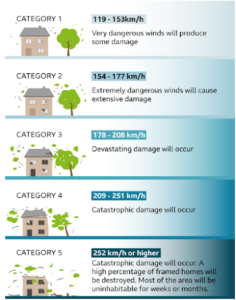In news– Hurricane Ida made a devastating effect in the USA recently.
About Hurricane Ida
- It is a weakening tropical depression that became the second most intense hurricane to strike the U.S. state of Louisiana on record, only behind Hurricane Katrina.
- Ida made landfall with 240km/h winds.
- It has been tied for the strongest landfall in the state by maximum winds with Hurricane Laura in 2020 and the 1856 Last Island hurricane.
- Ida was previously deemed “life-threatening”, drawing comparisons to Hurricane Katrina, a 2005 storm that had a path similar to Ida and killed 1,800 people.
- It has been considered as a category four hurricane – meaning it would cause severe damage to buildings, trees and power lines.

- It is the ninth named storm, fourth hurricane, and second major hurricane of the 2021 Atlantic hurricane season.
What is a tropical cyclone?
A tropical cyclone is the generic term for a non-frontal synoptic scale low-pressure system over tropical or sub-tropical waters with organized convection (i.e. thunderstorm activity) and definite cyclonic surface wind circulation.
Favourable conditions for its formation-
- Sufficiently warm sea surface temperatures (at least 26.5 °C).
- Atmospheric instability.
- High humidity in the lower to middle levels of the troposphere.
- Enough Coriolis force to develop a low-pressure center.
- A pre-existing low-level focus or disturbance.
- Low vertical wind shear.
Different names of Tropical Cyclones
- The terms “hurricane” and “typhoon” are regionally specific names for a strong “tropical cyclone” hence they are all the same.
- It’s just different names given to tropical storms in different parts of the world – hurricane in the Atlantic, typhoon in the Pacific and cyclone in the Indian Ocean.
- The World Meteorological Organization (WMO) and the United Nations Economic and Social Commission for Asia and the Pacific (ESCAP) started the tropical cyclone naming system in 2000.
- The process of naming cyclones involves several countries in the region and is done under the aegis of the WMO.
- Cyclones worldwide are named by 9 regions – North Atlantic, Eastern North Pacific, Central North Pacific, Western North Pacific, North Indian Ocean, South West Indian Ocean, Australian, Southern Pacific, South Atlantic.
















